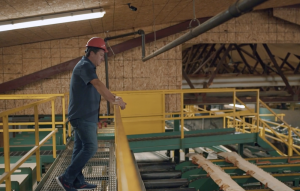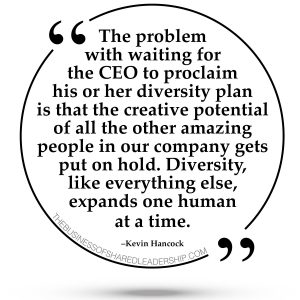“Do not wait for the green light. You are the green light.”
—Dr. Jacinta Mpalyenkana
Shortly after participating in the Leadership Learning Exchange for Equity sponsored by the Maine Community Foundation, I received a poignant question from one of my favorite global citizens within our company:
What are we doing to bring more underrepresented groups into our company?
I had barely finished reading the query when I quickly began typing a response. I was halfway through a hasty diatribe listing the “actions” I had taken, or would soon take, when I caught myself on the brink of breaking all of my most cherished rules of shared leadership and dispersed power.
 I was one of nearly six hundred people working at our company across sixteen sites. That company was woven into the fabric of many communities and supported by thousands of customers and supply partners. Yet here I was preparing to talk about what I alone would do. Ha!
I was one of nearly six hundred people working at our company across sixteen sites. That company was woven into the fabric of many communities and supported by thousands of customers and supply partners. Yet here I was preparing to talk about what I alone would do. Ha!
Thankfully I caught myself in time and regrouped. What I could do was important, especially as CEO, but it paled in comparison to what we could do together on the subject of expanding sexual, racial, and ethnic diversity within our company, specifically, and, more broadly, the lumber industry as a whole.
So I dragged that first e-mail over to the recycle bin, let it go, and started again. Here is a segment of the new message I composed and sent.
Thank you for bringing this question forth. First, I always maintain that our core accomplishment is to have a highly successful company that is sustaining more jobs, better jobs, and higher pay. I like making the overall economic pie bigger. We pay close attention to average and median wage earnings within our company, and we want them to grow FASTER than the national average and FASTER than inflation. For close to a decade now we have been able to do that. That’s the economic part.
Then there is the social part, and specifically the goal of broadening the diversity of who contributes to and benefits from our company’s success. In keeping with my personal value system of shared leadership, I think the ultimate solution is for all individuals who work at Hancock Lumber to expand their own personal networks in diverse ways AND then recommend, connect, and refer people from those enlarged communities to career opportunities within our company and industry. If every individual in our company were to engage with the subject of diversity on a personal level, that alone would move the needle you speak of. As the people within our company change (myself included, of course), our company will become something different.
Before sending that message I talked with our HR team and asked what percentage of our new hires came from internal referrals. The answer was about 50 percent. This data seemed to mathematically support shared leadership. If everyone in our company expanded the diversity of their personal network, this would invariably translate into more diversity within our company.
 The traditional, centralized model of hierarchical leadership would put the responsibility for crafting a “corporate diversity initiative” in the hands of a tiny, select group of individuals. That approach in itself is antithetical to broad inclusion. Conversely, everyone in the company could take up the cause and become a personal agent of change. At Hancock Lumber we have found time and again that when everyone owns the responsibilities of leadership, the outcomes are far more effective, dynamic, and sustainable.
The traditional, centralized model of hierarchical leadership would put the responsibility for crafting a “corporate diversity initiative” in the hands of a tiny, select group of individuals. That approach in itself is antithetical to broad inclusion. Conversely, everyone in the company could take up the cause and become a personal agent of change. At Hancock Lumber we have found time and again that when everyone owns the responsibilities of leadership, the outcomes are far more effective, dynamic, and sustainable.
The problem with waiting for the CEO to proclaim his or her diversity plan is that the creative potential of all the other amazing people in our company gets put on hold. In that model everyone else is relegated to the structured roles of spectator, evaluator, and “to-do list follower.”
Dispersed power is the key to expanding diversity within a company (or any community). Every person at Hancock Lumber has the capacity to broaden their network, reach out across traditionally divided lines, and make new friends in new places, starting today. If all 600 of us at Hancock Lumber each made 1 new friend from a previously unvisited community every ninety days, that would produce 2,400 new and diverse relationships in a year. A portion of those relationships would surely flow right into our company. All of those relationships would, more importantly, advance humanity.
There is no question that C-level leaders must prioritize diversity, but that’s best accomplished by inviting everyone within the organization to lead the new-friend-making and old-barrier-breaking work. Diversity, like everything else, expands one human at a time.
“Attempting to constantly control everyone and everything around you is not only exhausting . . . it is also futile. The only real power you can achieve in this life is being in control of yourself.”
—Anthon St. Maarten
Thank you for considering my thoughts. In return I honor yours. Every voice matters. Nestled between our differences lies our future.
__________